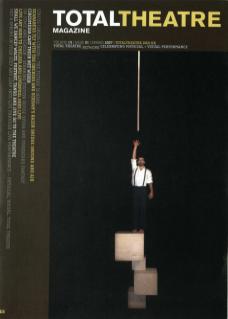Liverpool Live was commissioned by Bluecoat Arts Centre and The Live Art Development Agency as part of the Liverpool Biennial 2006, and took the city of Liverpool itself as its focus. The festival’s specific subject matter of Liverpool’s changing local and urban environment was very much in line with this year’s overall Biennial theme of ‘archipuncture’ (acupuncture for the built environment), which aimed to intervene into this ‘sick’ city in the midst of the Capital of Culture 2008 regeneration project. Within this specifically urban remit, the various performances and one-off happenings of Liverpool Live were challenged to engage wholly with the physical, political, and social fabric of the city.
The artists involved took true advantage of being given free rein over the city centre, situating live work in a variety of locations including shopping malls, boats, street corners, local galleries, and built theatres. This citywide theatre made punishing work for the festival’s audience who, corresponding perfectly with the Biennial notion of ‘archipuncture’, experienced the changing landscape of Liverpool directly underfoot whilst navigating massive construction sites and makeshift street diversions armed only with the ever-present bad festival map. However, for those fit enough to go the distance, the city yielded many well-deserved treats.
One of those treats was found, no thanks to the map, inside Parr Street Studios, where Kazuko Hohki’s Evidence for the Existence of Borrowers took groups on an epic twohour journey into the flawlessly miniature world of Liverpool’s small people, The Borrowers, and the Borrower International Network (BIN). Memorable moments of Hohki’s highly developed and quintessentially Japanese work included a slick boardroom DVD sales pitch led by the artist and BIN co-worker Mr Andy, the creation of a fully functioning Borrower education centre, and the grand concert finale that featured ‘genuine’ Borrower musical instruments. Whilst it’s true that Borrowers may not have arrived into Liverpool’s Albert Dock up the wide trouser legs of sailors or made Beatlesinspired rock music, the gigantic effort and obsessive attention to detail evident in this knowing performance piece is very real.
Another discovered treasure was Joshua Sofaer’s fake language gallery tour of Tate Liverpool’s World in One City, in which Sofaer enacted each nationality included in the Biennale’s international exhibition through cleverly skewed versions of the respective languages. Sofaer swooped between individual artworks talking fake Taiwanese, bogus Chinese, and mock American in a heady linguistic mix that was untranslatable yet strangely accurate. His work highlighted the distances these artworks have travelled to reach the global art market of Liverpool, journeys that imitate the colonial trade routes of Liverpool’s imperial past.
Alongside the festival’s more sculpted live pieces, there were many pared-down performances that created incidental occurrences intended to be witnessed by the casual passer-by. Extremely difficult to track down, these happenings maintained a direct involvement with the city by remaining firmly on the streets and deliberately using public space to engage with an (often unsuspecting) audience. The people queuing for Billie Piper’s autograph outside Waterstones on Bold Street did not realise that they were the lucky few to catch Sean Hawkridge’s intervention From The Sidelines but were compelled to join in nonetheless. Hawkridge’s spontaneous clapping spread throughout the confused queue of Piper fans like a contagiously happy rash. Nearby, the very tall Marcus Young was dressed head-to-toe in beige and walked one inch at a time up Liverpool’s busy Church Street. Young appeared unfazed by being stared at by pedestrians who impatiently rushed past him with bags stuffed full of shopping. His calm presence was uncanny and forced a pause that was at odds with the wet, grey Liverpool city centre.
However, it was Mat Fraser and Max Zadow’s bus tour, Everything You Wanted To Know About Access In The City, But Were Afraid To Ask, that completed the most obvious punctuating of Liverpool’s city surface. Loaded with both locals and festival-goers, the yellow and purple care-in-the-community bus intervened with the city on many levels, the most literal being the creation of a true urban blockage, the traffic jam, due to the wayward bus getting lost and making frequent sudden stops. The tour also enacted an important political function within the context of Liverpool Live: tour guide Mat Fraser provided cutting dialogue that exposed Liverpool’s problematic disabled, social, and political access issues, thus uncovering dark secrets that the architectural façade of the city conceals. In keeping with this subversive agenda, highlights of the tour were a dubious Tour of Toxteth, the blocked-off disabled access in the Everyman Theatre (boo), the concrete steps that form the only access to the Liverpool Metropolitan Cathedral (hiss), and Upper Stanhope Street, where Hitler once lived (allegedly). Nothing sacred for the city was spared, as Mat sacrilegiously sent up the Pope, Cilla Black, and Beatle John Lennon (for his infamous ‘Spazza’ impression of people with cerebral palsy).
The tour ended back at Roscoe Lane with a fitting tribute: ‘This tour is dedicated to the people of Liverpool, to Hitler, the Pope, Boris Johnson, The Sun, Ken Dodd, and our proud sponsors, The Bluecoat Arts Centre.’ All in all it made for an uncomfortable ride: but from its unmediated street-side position, the tour harnessed the raw power of performance, grounded in the everyday, and effectively mobilised real anxieties around issues of disability to create a joyously scandalous zone of sanctioned ‘un-pc’-ism that is too important to be left on the bus.
Rachel Lois Clapham is a writer with Writing From Live Art, a Live Art UK initiative.

